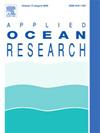Fuzzy-based ensemble methodology for accurate long-term prediction and interpretation of extreme significant wave height events
IF 4.3
2区 工程技术
Q1 ENGINEERING, OCEAN
引用次数: 0
Abstract
Providing an accurate prediction of Significant Wave Height (SWH), and specially of extreme SWH events, is crucial for coastal engineering activities and holds major implications in several sectors as offshore renewable energy. With the aim of overcoming the challenge of skewness and imbalance associated with the prediction of these extreme SWH events, a fuzzy-based cascade ensemble of regression models is proposed. This methodology allows to remarkably improve the predictive performance on the extreme SWH values, by using different models specialised in different ranges on the target domain. The method’s explainability is enhanced by analysing the contribution of each model, aiding in identifying those predictor variables more characteristic for the detection of extreme SWH events. The methodology has been validated tackling a long-term SWH prediction problem, considering two case studies over the southwest coast of the United States of America. Both reanalysis data, providing information on various meteorological factors, and SWH measurements, obtained from the nearby stations and the station under examination, have been considered. The goodness of the proposed approach has been validated by comparing its performance against several machine learning and deep learning regression techniques, leading to the conclusion that fuzzy ensemble models perform much better in the prediction of extreme events, at the cost of a slight deterioration in the rest of the samples. The study contributes to advancing the SWH prediction field, specially, to understanding the behaviour behind extreme SWH events, critical for various sectors reliant on oceanic conditions.
基于模糊的集合方法,用于长期准确预测和解释极端显著波高事件
准确预测显著波高(SWH),特别是极端显著波高事件,对海岸工程活动至关重要,并对海上可再生能源等多个领域产生重大影响。为了克服与预测这些极端 SWH 事件相关的偏斜和不平衡挑战,提出了一种基于模糊的级联回归模型集合。通过在目标域的不同范围内使用不同的专业模型,该方法可显著提高对极端西南暖流值的预测性能。通过分析每个模型的贡献,提高了该方法的可解释性,有助于确定那些对检测极端 SWH 事件更有特征的预测变量。通过对美国西南海岸的两个案例研究,对该方法进行了验证,以解决长期西南暖流预测问题。既考虑了提供各种气象因素信息的再分析数据,也考虑了从附近站点和被研究站点获得的 SWH 测量数据。通过与几种机器学习和深度学习回归技术的性能比较,验证了所提方法的优越性,得出的结论是模糊集合模型在预测极端事件方面的性能要好得多,但其他样本的性能略有下降。这项研究有助于推动西南暖流预测领域的发展,特别是有助于理解极端西南暖流事件背后的行为,这对依赖海洋条件的各行各业至关重要。
本文章由计算机程序翻译,如有差异,请以英文原文为准。
求助全文
约1分钟内获得全文
求助全文
来源期刊

Applied Ocean Research
地学-工程:大洋
CiteScore
8.70
自引率
7.00%
发文量
316
审稿时长
59 days
期刊介绍:
The aim of Applied Ocean Research is to encourage the submission of papers that advance the state of knowledge in a range of topics relevant to ocean engineering.
 求助内容:
求助内容: 应助结果提醒方式:
应助结果提醒方式:


